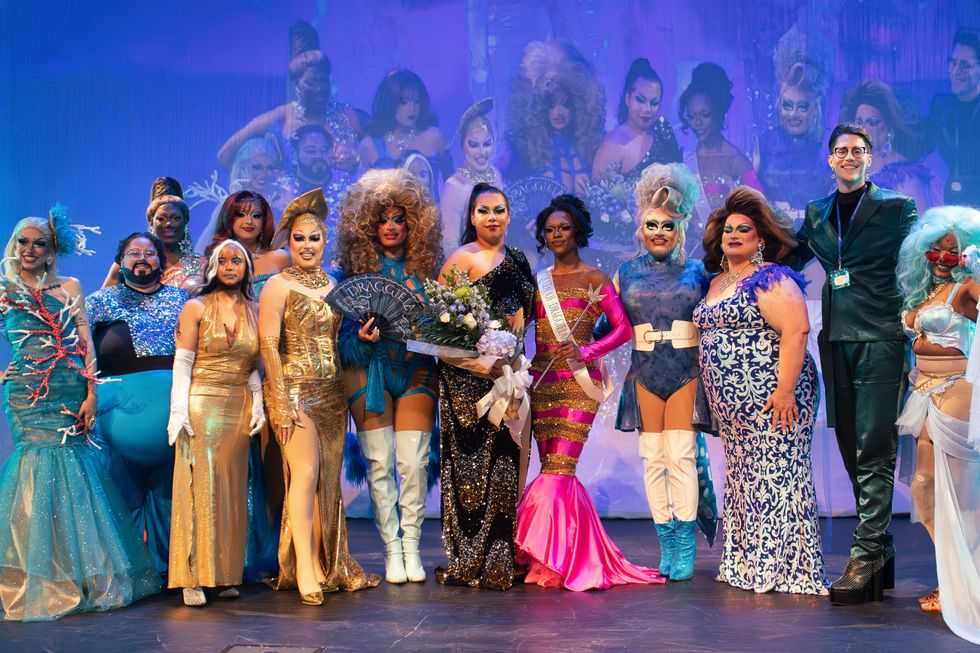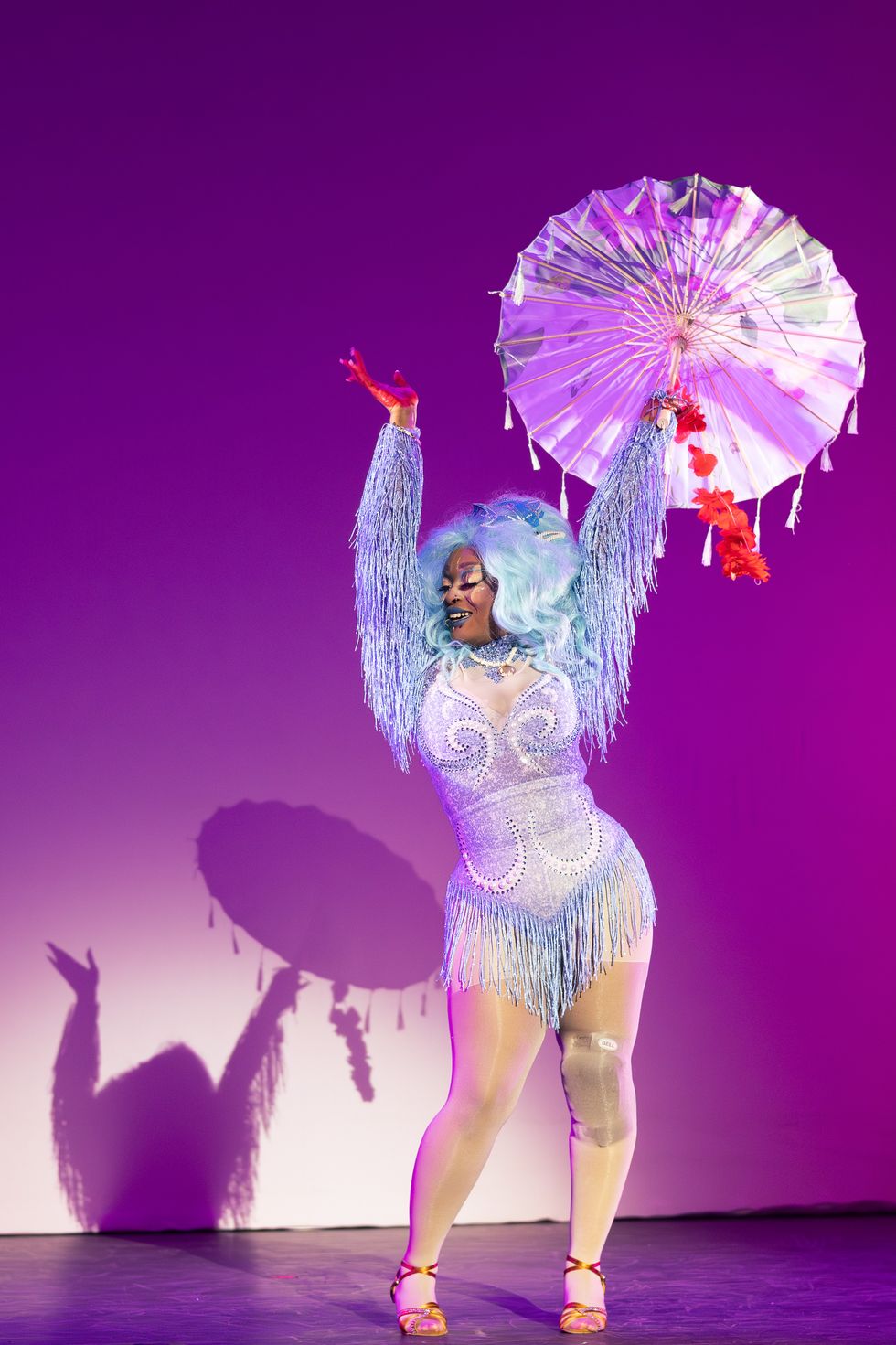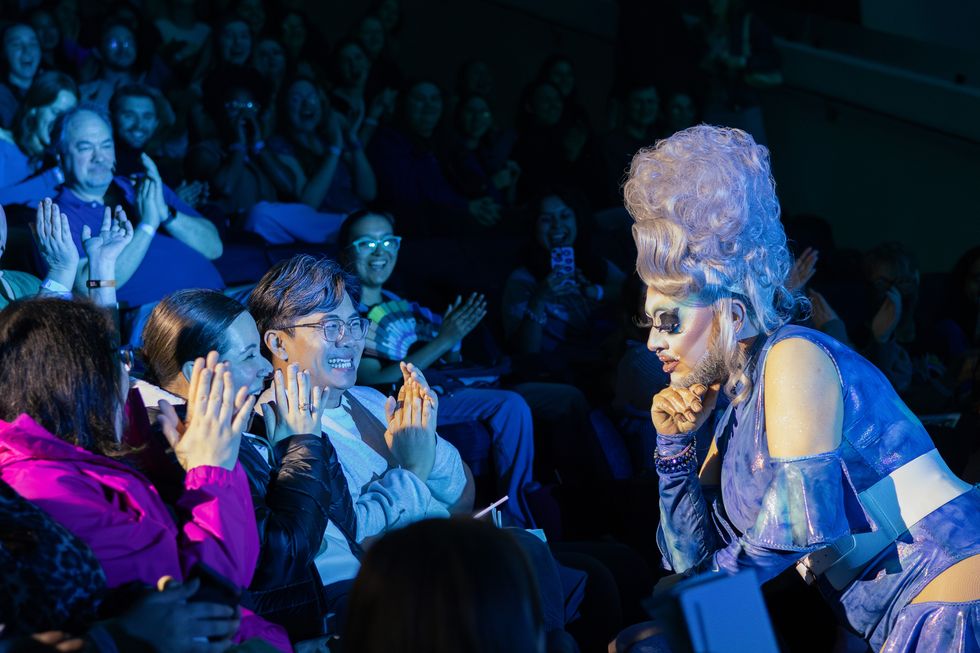To say that Daan Roosegaarde “thinks big” would surely be an understatement. The Dutch artist’s ambitious work marries existing systems in nature and technology, acting as a kind of adapter between the unpredictable and the futuristic. Take, for example, Roosegaarde’s most recent SMOG project in Beijing, a “vacuum” of copper coils that form an electrostatic field, attracting smog particles and creating a void of clean air. Or some of his related work with pollution, such as a ring made up of compressed smog particles. Even calling his work “art” at all feels a little strange when talking about design projects like Smart Highway, which paints road pavement with photoluminescent powder, reducing the need for street lamps; it also features special lanes that charge electric cars while they are driving. Roosegaarde has even proposed a way to harness the luminescent qualities of fireflies to create “glow-in-the-dark trees.”
Marine life, biomimicry, and glowing paint seem like unlikely and even far-fetched mediums for solving some of the world’s faulty design systems and environmental problems, but Roosegaarde believes that by spanning the gaps between aesthetic, natural, and technological advancement we can intuitively advance into a better and more efficient future. From Shanghai to the Netherlands (Roosegaarde’s bases of operation) and everywhere in between, the artist’s concepts offer cities and citizens innovative approaches to evolving landscapes—or, at the very least, a lot of food for thought.
Nature and technology seem like opposing forces, but you’ve managed to find a way to harness both in your projects.
I was born in Netherlands, where we live under sea level. So in a way our whole landscape is already man- or woman-made. It’s because of the water management and dyke system and everything that we are able to survive. Every tree that you see here is therefore planted. So this relation between nature and technology is, I think, within the DNA of a country like the Netherlands already.
I also see a lot of similarity between nature and how technology is evolving. I think of tech as a second language, as a second skin, and not to emphasize the George Orwell scenario where it dominates us and starts to limit our options as human beings, but more the Leonardo da Vinci scenario—where we learn how to fly, or where we inform ourselves about our health, or we can share our dreams.
As we become more reliant on technology, does it seem we’re going back to nature to find solace?
That’s the beauty of nature. You just want to surrender to something bigger than you, something that is out of your control. The natural element is where we let go somehow. You see that with technology as well. It becomes more proactive and more suggestive. Your Amazon says, “Hey, you just purchased this book; maybe you want to have this one as well.” It starts to think along with you, as your body. We’ll see where it takes us.
Do you think about scenarios in which technology eventually takes over and we become victims of our own making?
I think from day one, from you and I on the prairie, living in caves, we’ve always created things to explore life, to explore reality. We created fire to be warm, to share stories, to make food. We invented the wheel as an extension of our legs. We invented glasses as an extension of our eyes. We invented the laptop as an extension of our voice and of our brain, in a way. We’ve always tried to make things so personalized, to make the world understandable. I think it becomes doubtable when it gets too much a mind of its own, and we do not know who’s in control anymore. That’s exactly the phase we’re in. On the other hand, in the movie Her, you see that there’s a whole different scenario as well. We’re not looking at screens the whole time anymore; it becomes a part of us—you can fall in love with it.
The environment is totally inconsistent and unreliable, yet you’ve chosen it as one the primary mediums in your work.
You have a clear vision of what you want to achieve, but it’s more like a taste in your mouth, which you do not know the ingredients yet. That’s when you start to write, to read, to travel, to talk, to work together, to get other experts, to figure out. You make things, but the making also makes you. Like the Smog Rings came after we started to design the Smog Free Park, where the pollution, actually, the smog particles, were waste from the pilots we were doing. Then we suddenly realized we should not throw this away. Let’s use it to design with, as an ingredient. And so we started to compress it, and now we make the rings which, when you share one, you donate a thousand cubic meters of clean air to the city of Beijing.
It’s transformed the project incredibly because suddenly people realize that they can be part of the solution, not just part of the problem. Suddenly they move from just being a taxpayer to a citizen, to a concerned citizen. And so it’s definitely not about technology—it’s about triggering new social interactions on a landscape level, to engage people with that, and sort of the whole notion of interactivity or openness. Whether it’s a Crystal, the crystals of light in the public space in Eindhoven, or the Dune, which follows you, or the Intimacy Dresses, or the Sustainable Dance Floor, which generates power when you dance on it, it always tries to make you aware of the relational network we are in.
You have offices in Shanghai and the Netherlands, and you split your time between the two.
Home is where the laptop is, so to speak. The coming weeks are sort of focused on the new ideas, new projects. There’s a big public light artwork in Centraal Station in Amsterdam, a 15-by-45 meter sort of hologram light artwork at Schiphol, the airport. And we’re working on light-emitting trees, where we’re taking the luciferin from fireflies to see how we can merge them with a plant. We’re working on the light-emitting bicycle paths, a sort of special form of Smart Highway. There’s a lot about nature, a lot about technology, a lot about the future. And about poetry, to create things that trigger your imagination.
Tell us more about the Smog Free Project in Beijing.
It started with me in a room in Beijing on a high building looking at the city around me. On Monday, I could see the architecture, the people, and on Tuesday and Wednesday, it was completely covered with smog. So it was sort of veiled, this cover, which is poisonous and at the same time sort of sad, in a way. I realized that maybe this is my “ingredient.” As Van Gogh has his paint, maybe I have my smog particles. We started to see, how can we work with it, using the principle of static electricity to suck up smog, so we can play with it. Then we thought, let’s create a place, which is the cleanest spot in China, in Beijing. The notion of a public space where the absence of smog is the actual design. It’s not the solution, but it’s a sort of bottom-up approach, which I think is really important to trigger the creativity of people to solve big, big, big world problems.
How did you get the support of the Chinese government for this?
The Chinese president launched a “War on Smog” two or three years ago, with a $165 million program to get the city of Beijing smog-free. So, you’re right, five years ago this project would have never made the press. But they realize it’s a problem. They have to admit it’s not fog or sand dust, you know? It’s there to stay, and it’s not going to get better out of itself. You can say, “Drive less in a car,” but nobody’s going to do that. It’s China. They want to do more, not less. So what we say is, “Stop making an old system 10 percent less worse. Let’s start investing in the new world.”
How much are you concerned with the political climate when you propose projects around the world?
When I present a radical project to a client in New York, in the USA, there’s a tendency to ask, “Are you sure you’ve done this before?” in terms of liability and all these kind of things. But when I present a project in China, they ask me, “Are you sure this is the first time?” because they want to be the first! But beyond that, there’s a whole cultural reference. For example, in Europe we grew up with the technological revolution. We moved from black-and-white television to color to LCD to plasma to HD to 3-D television. If you go to Seoul or to a certain place in China, it’s nothing, and then bam! It’s a 15 million person city. So they have a completely different emotional relationship and reference of the past, and therefore also of the future.
We exhibited Dune in Slovenia, which was a dictatorship not so long ago. People were scared of Dune. Because when they grew up, the walls had ears, and they were spied on. And suddenly they had this piece, which was reacting to them and following them, and they were like, “Uh, this is—whoa!” But when we showed it in Hong Kong, the children in the city adapted it as their friend. They mimicked the sounds of Dune to communicate with each other.
I imagine the Intimacy Dress would be received in various cultures in different ways.
I was almost arrested in Kuala Lumpur. It’s a Muslim country. But if I take too much into consideration how people might be offended by what I do, then we can just stop and live in a cave again. We never do it intentionally. It’s not a provocation; it’s a proposal.
What does “good” mean to you?
The bad, but then updated. An updated badness.
What did you think you’d first be when you grew up?
I had no idea. I think I always had a desire to make things, tree huts, laying around in nature. I think when I was 16 I walked an entire museum for the first time. I saw these gigantic dark wooden models of squares and buildings and towers. That was the work of Arata Isozaki, a famous architect in Japan. That’s the first time I realized that what I was doing as a child, building stuff and exploring, was actually a profession. Nobody told me that before.
What is something that you’ve failed at?
You’ve got an hour? Reality’s brutal, harsh, and does not want to change. So in the beginning it was hard to let go, when you grow, when your ideas become so big you cannot do it alone. You have to let go and share control with other people and trust them to take care of your baby. So maybe the failure in the beginning was that there was too much control from my side, which limited in a way the growth and the exploration of the idea.
What’s the best and worst advice you’ve ever received?
The worst advice is when somebody says, “Stick to your expertise. Stick to your discipline.” That was one of the worst pieces of advice because it was limiting, instead of focusing and concentrating. The best one was, to really go for it, and to really invest in your dreams, and to always focus on the big picture. Yes, there will be people telling you it’s not possible, it cannot be done, or it already exists. It’s your job to sort of quietly, with love, ignore them. You can listen to them, but not too much.
Do you have any words that you live by these days?
We have a saying in the studio right now. We do the things MAYA: Most Advanced, Yet Acceptable. We’re always looking for the edge of what is and what is not possible, logically speaking. That’s because you want to talk about the future, but if you go too far, people get lost. And be the “hippie with a business plan.” Believe in your dreams, and at the same time create an environment where you can realize them. There will always be people telling you it’s not possible. But there’s a lot of beauty and a lot of bullshit, and one should realize that.















 Let us all bow before Gary, the Internet's most adventurous feline. Photo credit: James Eastham
Let us all bow before Gary, the Internet's most adventurous feline. Photo credit: James Eastham Gary the Cat enjoys some paddling. Photo credit: James Eastham
Gary the Cat enjoys some paddling. Photo credit: James Eastham James and Gary chat with Ryan Reed and Tony Photo credit: Ryan Reed
James and Gary chat with Ryan Reed and Tony Photo credit: Ryan Reed


 Rock deterioration has damaged some of the inscriptions, but they remain visible. Renan Rodrigues Chandu and Pedro Arcanjo José Feitosa, and the Casa Grande boys
Rock deterioration has damaged some of the inscriptions, but they remain visible. Renan Rodrigues Chandu and Pedro Arcanjo José Feitosa, and the Casa Grande boys The Serrote do Letreiro site continues to provide rich insights into ancient life.
The Serrote do Letreiro site continues to provide rich insights into ancient life.

 The contestants and hosts of Draggieland 2025Faith Cooper
The contestants and hosts of Draggieland 2025Faith Cooper Dulce Gabbana performs at Draggieland 2025.Faith Cooper
Dulce Gabbana performs at Draggieland 2025.Faith Cooper Melaka Mystika, guest host of Texas A&M's Draggieland, entertains the crowd
Faith Cooper
Melaka Mystika, guest host of Texas A&M's Draggieland, entertains the crowd
Faith Cooper


